The road signs of the Kingdom of the Netherlands (the Netherlands and six Dutch Caribbean islands), as well as Suriname,[1] are regulated in the Reglement verkeersregels en verkeerstekens 1990, commonly abbreviated as RVV 1990. While most previous signage, from the RVV 1966 (Dutch) remained legal and official, they have been updated / replaced. Some aren't official anymore and have lost legal validity, but most surviving old signs remained valid.
Speed restrictions
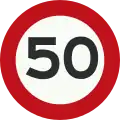 A1: Speed limit (50 km/h)
A1: Speed limit (50 km/h) A2: End of speed limit (50 km/h)
A2: End of speed limit (50 km/h) A3: Speed limit displayed on an electronic display panel
A3: Speed limit displayed on an electronic display panel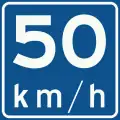 A4: Recommended speed
A4: Recommended speed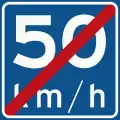 A5: End of recommended speed
A5: End of recommended speed
Priority
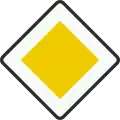 B1: Priority road (formally used
B1: Priority road (formally used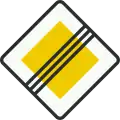 B2: End of priority road
B2: End of priority road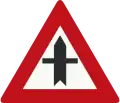 B3: Crossroads with priority
B3: Crossroads with priority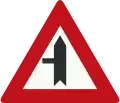 B4: Road junction with priority over minor road from the left
B4: Road junction with priority over minor road from the left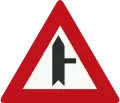 B5: Road junction with priority over minor road from the right
B5: Road junction with priority over minor road from the right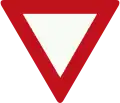 B6: Give Way sign, must give priority to other traffic on the main road ahead
B6: Give Way sign, must give priority to other traffic on the main road ahead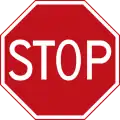 B7: Stop: Give priority to traffic on the main road ahead (formerly used
B7: Stop: Give priority to traffic on the main road ahead (formerly used.svg.png.webp) )
)
Road closed prohibition and mandatory
 C1: Road closed in both directions to vehicles, riders and persons in charge of animals or livestock
C1: Road closed in both directions to vehicles, riders and persons in charge of animals or livestock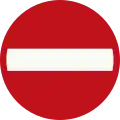 C2: No entry in this direction for vehicular traffic, horse riders and persons in charge of animals or livestock
C2: No entry in this direction for vehicular traffic, horse riders and persons in charge of animals or livestock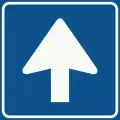 C3: One-way street
C3: One-way street.svg.png.webp) C4: One-way street
C4: One-way street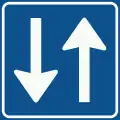 C5: Access permitted for both sides
C5: Access permitted for both sides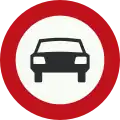 C6: No access for vehicles with more than two wheels (formerly used
C6: No access for vehicles with more than two wheels (formerly used )
)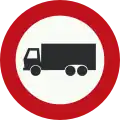 C7: No access for goods vehicles (formerly used
C7: No access for goods vehicles (formerly used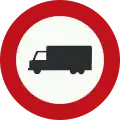 )
)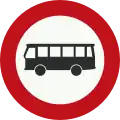 C7a: Closed to buses
C7a: Closed to buses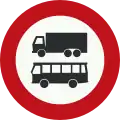 C7b: Closed to buses and goods vehicles
C7b: Closed to buses and goods vehicles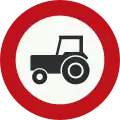 C8: No access for agricultural vehicles. (formerly used
C8: No access for agricultural vehicles. (formerly used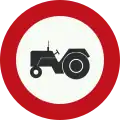 )
)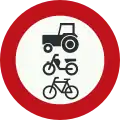 C9: No access for riders, cattle, wagons, agricultural vehicles, microcars, bicycles, mopeds or invalid carriages
C9: No access for riders, cattle, wagons, agricultural vehicles, microcars, bicycles, mopeds or invalid carriages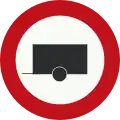 C10: No access for motor vehicle towing trailers (formerly used
C10: No access for motor vehicle towing trailers (formerly used )
)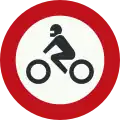 C11: No access for motor cycles (formerly used
C11: No access for motor cycles (formerly used )
)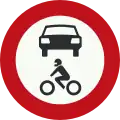 C12: No access for motor vehicles (formerly used
C12: No access for motor vehicles (formerly used )
)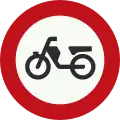 C13: No access for mopeds, motor-assisted bicycles or motor-powered invalid carriages (formerly used
C13: No access for mopeds, motor-assisted bicycles or motor-powered invalid carriages (formerly used )
)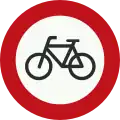 C14: No access for bicycles or for non-motor-powered invalid carriages (formerly used
C14: No access for bicycles or for non-motor-powered invalid carriages (formerly used )
)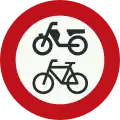 C15: No access for bicycles, mopeds and invalid carriages (formerly used
C15: No access for bicycles, mopeds and invalid carriages (formerly used )
)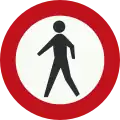 C16: No access for pedestrians (formerly used
C16: No access for pedestrians (formerly used )
)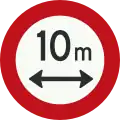 C17: No access for vehicles or combinations of vehicles with a length, including the load, greater than indicated (formerly used
C17: No access for vehicles or combinations of vehicles with a length, including the load, greater than indicated (formerly used )
)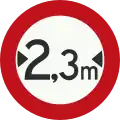 C18: No access for vehicles with a width, including the load, greater than indicated
C18: No access for vehicles with a width, including the load, greater than indicated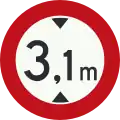 C19: No access for vehicles with a height, including the load, greater than indicated
C19: No access for vehicles with a height, including the load, greater than indicated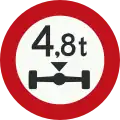 C20: No access for vehicles with an axle load greater than indicated
C20: No access for vehicles with an axle load greater than indicated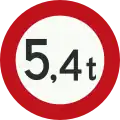 C21: No access for vehicles or combinations of vehicles with a total weight greater than indicated
C21: No access for vehicles or combinations of vehicles with a total weight greater than indicated C22: No access for vehicles carrying hazardous substances
C22: No access for vehicles carrying hazardous substances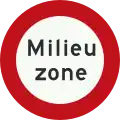 C22a: Environmental zone: no access for vehicles not compliant with article 86d of RVV 1990
C22a: Environmental zone: no access for vehicles not compliant with article 86d of RVV 1990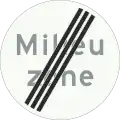 C22b: End of environmental zone
C22b: End of environmental zone C23-01: Rush-hour lane open
C23-01: Rush-hour lane open C23-02: Clear rush-hour lane
C23-02: Clear rush-hour lane C23-03: Rush-hour lane closed
C23-03: Rush-hour lane closed
Signs giving positive instructions
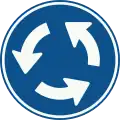 D1: Roundabout – give way to vehicles on the immediate left
D1: Roundabout – give way to vehicles on the immediate left D2: Instruction to all drivers to keep to the right of the sign (or left if arrow is reversed)
D2: Instruction to all drivers to keep to the right of the sign (or left if arrow is reversed) D3: The sign may be passed on either side
D3: The sign may be passed on either side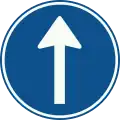 D4: Instruction to drive ahead only (formerly used
D4: Instruction to drive ahead only (formerly used )
)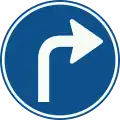 D5: Instruction to follow the direction ahead shown by the arrow (formerly used
D5: Instruction to follow the direction ahead shown by the arrow (formerly used or
or  )
) 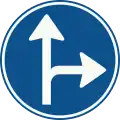 D6: Instruction to follow one of the directions ahead shown by the arrows (formerly used
D6: Instruction to follow one of the directions ahead shown by the arrows (formerly used )
)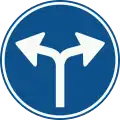 D7: Instruction to follow one of the directions ahead shown by the arrows
D7: Instruction to follow one of the directions ahead shown by the arrows
Parking and stopping
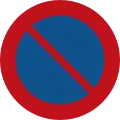 E1: No parking
E1: No parking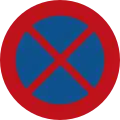 E2: No parking and stopping
E2: No parking and stopping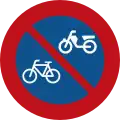 E3: No parking for bicycles or mopeds
E3: No parking for bicycles or mopeds E4: Parking area
E4: Parking area E5: Taxi rank
E5: Taxi rank E6: Parking for disabled drivers
E6: Parking for disabled drivers E7: Parking permitted for the immediate loading and unloading of goods only
E7: Parking permitted for the immediate loading and unloading of goods only E8: Parking facilities only for the category or group of vehicle shown
E8: Parking facilities only for the category or group of vehicle shown E9: Parking for permit-holders only
E9: Parking for permit-holders only E10: Entrance to controlled parking zone
E10: Entrance to controlled parking zone E11: End of controlled parking zone
E11: End of controlled parking zone E12: Park and ride facilities
E12: Park and ride facilities E13: Parking facilities for car sharers
E13: Parking facilities for car sharers
Other signs giving orders
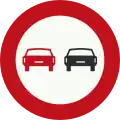 F1: No overtaking
F1: No overtaking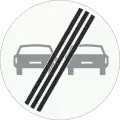 F2: End of no overtaking zone
F2: End of no overtaking zone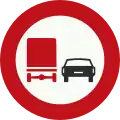 F3: No overtaking of cars by lorries
F3: No overtaking of cars by lorries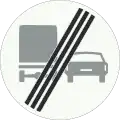 F4: End of zone with no overtaking of cars by lorries
F4: End of zone with no overtaking of cars by lorries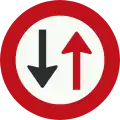 F5: Give way to oncoming vehicles
F5: Give way to oncoming vehicles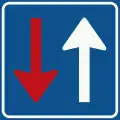 F6: Priority over oncoming vehicles
F6: Priority over oncoming vehicles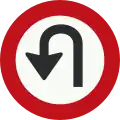 F7: No U-turns (formerly used
F7: No U-turns (formerly used )
)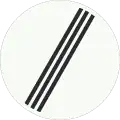 F8: End of all restrictions imposed by traffic signs
F8: End of all restrictions imposed by traffic signs F9: End of all restrictions imposed by electronic signalling panels
F9: End of all restrictions imposed by electronic signalling panels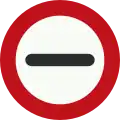 F10: Stop. The sign can also contain further information as to whom it is directed and why
F10: Stop. The sign can also contain further information as to whom it is directed and why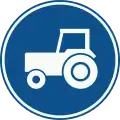 F11: Compulsory use of passing lane for slow motor vehicles (under 25 km/h)
F11: Compulsory use of passing lane for slow motor vehicles (under 25 km/h)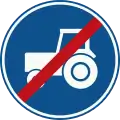 F12: End of passing lane for slow motor vehicles
F12: End of passing lane for slow motor vehicles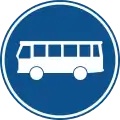 F13: Bus lane
F13: Bus lane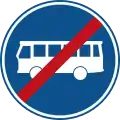 F14: End of bus lane
F14: End of bus lane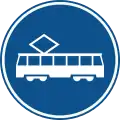 F15: Tram lane
F15: Tram lane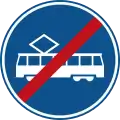 F16: End of tram lane
F16: End of tram lane F17: Bus and tram lane
F17: Bus and tram lane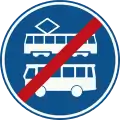 F18: End of bus and tram lane
F18: End of bus and tram lane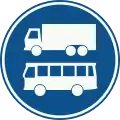 F19: Compulsory use of lane only for trucks and buses
F19: Compulsory use of lane only for trucks and buses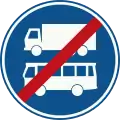 F20: End of lane only for trucks and buses
F20: End of lane only for trucks and buses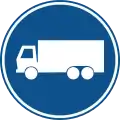 F21: Compulsory use of lane only for trucks
F21: Compulsory use of lane only for trucks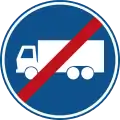 F22: End of lane only for trucks
F22: End of lane only for trucks
Traffic regulations
 G1: Motorway
G1: Motorway G2: End of motorway
G2: End of motorway G3: Expressway (formerly used
G3: Expressway (formerly used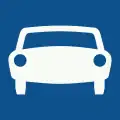 )
)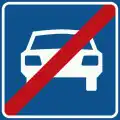 G4: End of Expressway (formerly used
G4: End of Expressway (formerly used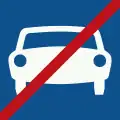 )
) G5: Living street (formerly used
G5: Living street (formerly used.svg.png.webp) )
) G6: End of Living street (formerly used
G6: End of Living street (formerly used.svg.png.webp) )
)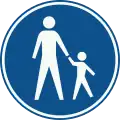 G7: Footpath (formerly used
G7: Footpath (formerly used )
)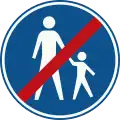 G8: End of footpath
G8: End of footpath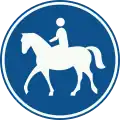 G9: Bridleway
G9: Bridleway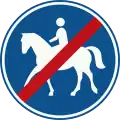 G10: End of bridleway
G10: End of bridleway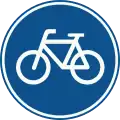 G11: Route for pedal cycles only (formerly used
G11: Route for pedal cycles only (formerly used )
) G12: End of pedal cycles route
G12: End of pedal cycles route G12a: Route for pedal cycle and mopeds only
G12a: Route for pedal cycle and mopeds only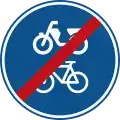 G12b: End of route for pedal cycles and mopeds
G12b: End of route for pedal cycles and mopeds G13: Optional cycle path (formerly used
G13: Optional cycle path (formerly used )
) G14: End of optional cycle path
G14: End of optional cycle path
Built-up area
 H1: Built-up area
H1: Built-up area H2: End of built-up area
H2: End of built-up area
Warning signs
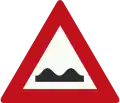 J1: Uneven road
J1: Uneven road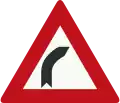 J2: Bend to right
J2: Bend to right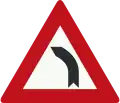 J3: Bend to left
J3: Bend to left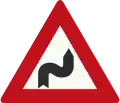 J4: Double bend, first to right
J4: Double bend, first to right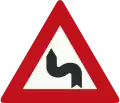 J5: Double bend, first to left
J5: Double bend, first to left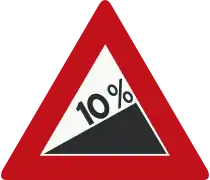 J6: Steep hill upward
J6: Steep hill upward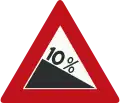 J7: Steep hill downward
J7: Steep hill downward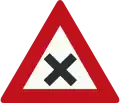 J8: Dangerous crossing
J8: Dangerous crossing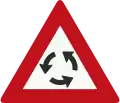 J9: Roundabout
J9: Roundabout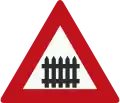 J10: Level crossing with barrier or gates ahead
J10: Level crossing with barrier or gates ahead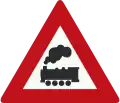 J11: Level crossing without barrier or gates ahead (formerly used
J11: Level crossing without barrier or gates ahead (formerly used )
) J12: Level crossing with single track
J12: Level crossing with single track J13: Level crossing with two or more tracks
J13: Level crossing with two or more tracks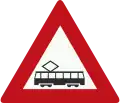 J14: Tram (crossing) ahead (formerly used
J14: Tram (crossing) ahead (formerly used )
)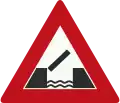 J15: Opening or swing bridge ahead (formerly used
J15: Opening or swing bridge ahead (formerly used )
)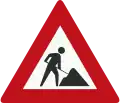 J16: Road works ahead (formerly used
J16: Road works ahead (formerly used )
)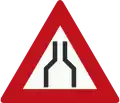 J17: Road narrows on both sides
J17: Road narrows on both sides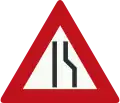 J18: Road narrows on the right side
J18: Road narrows on the right side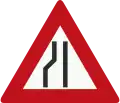 J19: Road narrows on the left side
J19: Road narrows on the left side J20: Slippery road (formerly used
J20: Slippery road (formerly used )
)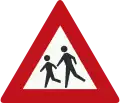 J21: School crossing (formerly used
J21: School crossing (formerly used )
)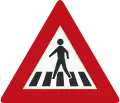 J22: Pedestrian crossing (formerly used
J22: Pedestrian crossing (formerly used )
)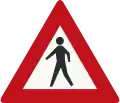 J23: Pedestrians
J23: Pedestrians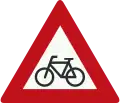 J24: Cyclists and moped riders (formerly used
J24: Cyclists and moped riders (formerly used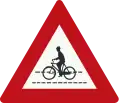 )
)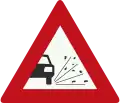 J25: Loose chippings (formerly used
J25: Loose chippings (formerly used )
)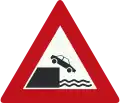 J26: Quayside or river bank (formerly used
J26: Quayside or river bank (formerly used )
)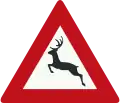 J27: Wild animals
J27: Wild animals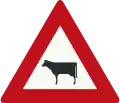 J28: Livestock
J28: Livestock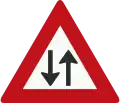 J29: Two-way traffic
J29: Two-way traffic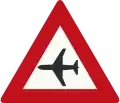 J30: Low-flying aircraft
J30: Low-flying aircraft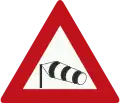 J31: Side winds (formerly used
J31: Side winds (formerly used )
)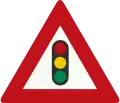 J32: Traffic lights
J32: Traffic lights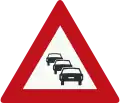 J33: Queues likely (formerly used
J33: Queues likely (formerly used )
)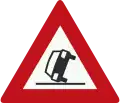 J34: Danger of accidents
J34: Danger of accidents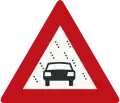 J35: Reduced visibility because of snow, rain or fog (formerly used
J35: Reduced visibility because of snow, rain or fog (formerly used )
)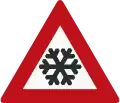 J36: Risk of ice or snow
J36: Risk of ice or snow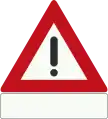 J37: Danger. Details of the danger are shown on the plate beneath (formerly used
J37: Danger. Details of the danger are shown on the plate beneath (formerly used.svg.png.webp) )
)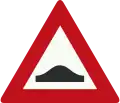 J38: Warning bump
J38: Warning bump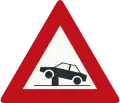 J39: Warning for retractable bollard (poller) in the traffic lane that can be used to regulate access to streets and areas.
J39: Warning for retractable bollard (poller) in the traffic lane that can be used to regulate access to streets and areas. level crossing distance board(close)
level crossing distance board(close) level crossing distance board(between)
level crossing distance board(between) level crossing distance board(far)
level crossing distance board(far)
Direction
 K1: Low level motorway information sign showing both main and intermediary destinations and the motorway number (old)
K1: Low level motorway information sign showing both main and intermediary destinations and the motorway number (old)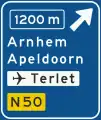 K2: Advance warning sign of a motorway showing the distance to the next exit and destinations after the exit (the top destination is the name of the exit), direction to aerodrome/airport and the road number (non-motorway)(old)
K2: Advance warning sign of a motorway showing the distance to the next exit and destinations after the exit (the top destination is the name of the exit), direction to aerodrome/airport and the road number (non-motorway)(old)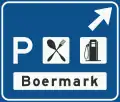 K3: Information sign for exit to motorway service area, showing the name of the rest area and symbols for the services offered (old)
K3: Information sign for exit to motorway service area, showing the name of the rest area and symbols for the services offered (old) K4: High level motorway information sign showing lane instructions for through traffic and exit panel showing intermediary destinations, with the motorway number and European route numbers (old)
K4: High level motorway information sign showing lane instructions for through traffic and exit panel showing intermediary destinations, with the motorway number and European route numbers (old)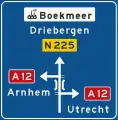 K5: Non-motorway advance information panel showing intermediary destinations, road numbers, a viaduct symbol and a sign for an industrial zone
K5: Non-motorway advance information panel showing intermediary destinations, road numbers, a viaduct symbol and a sign for an industrial zone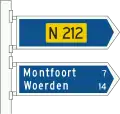 K6: Non-motorway information panels showing intermediary destinations and non-motorway road numbers
K6: Non-motorway information panels showing intermediary destinations and non-motorway road numbers K7: Signposts for cyclists and moped riders (finger posts) showing local and intermediary destinations, municipal cycle route numbers (above) and showing intermediary destinations and intermediary cycle route numbers (below)
K7: Signposts for cyclists and moped riders (finger posts) showing local and intermediary destinations, municipal cycle route numbers (above) and showing intermediary destinations and intermediary cycle route numbers (below) K8: Signposts (multiple) for cyclists and moped riders showing intermediary destinations and indicating an alternative route (in italics) to one of the destinations
K8: Signposts (multiple) for cyclists and moped riders showing intermediary destinations and indicating an alternative route (in italics) to one of the destinations K9: Diversion with alternative route shown on an advance warning panel for a non-motorway highway
K9: Diversion with alternative route shown on an advance warning panel for a non-motorway highway K10: Advance warning panel within a built-up area showing an intermediary destination, local destinations, local tourist sights, local facilities and road numbers through the town
K10: Advance warning panel within a built-up area showing an intermediary destination, local destinations, local tourist sights, local facilities and road numbers through the town K11: Lane instructions on a non-motorway highway. Panel showing intermediary destinations, road numbers and directions to a motorway
K11: Lane instructions on a non-motorway highway. Panel showing intermediary destinations, road numbers and directions to a motorway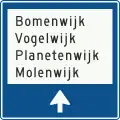 K12: Local signpost within a built-up area showing names of individual districts (in traffic areas)
K12: Local signpost within a built-up area showing names of individual districts (in traffic areas)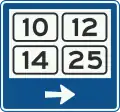 K13: Signpost within a built-up area showing district numbers (in traffic areas)
K13: Signpost within a built-up area showing district numbers (in traffic areas) K14: Route for the conveyance of hazardous materials
K14: Route for the conveyance of hazardous materials
Information
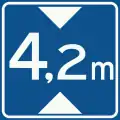 L1: No vehicles over height shown, underpass
L1: No vehicles over height shown, underpass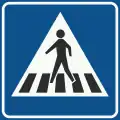 L2: Pedestrian crossing (formerly used
L2: Pedestrian crossing (formerly used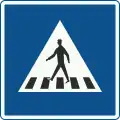 )
)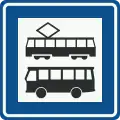 L3a: Tram stop/bus stop
L3a: Tram stop/bus stop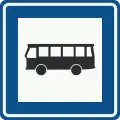 L3b: Bus stop
L3b: Bus stop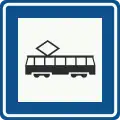 L3c: Tram stop
L3c: Tram stop L4: Get in lane
L4: Get in lane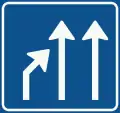 L5: End of lane
L5: End of lane L6: Lane fork
L6: Lane fork L7: Number of through lanes
L7: Number of through lanes L8: No through road for vehicles (formerly used
L8: No through road for vehicles (formerly used )
) L9: Advance warning of a no through road for vehicles
L9: Advance warning of a no through road for vehicles L10: Advance warning of traffic information for the direction shown
L10: Advance warning of traffic information for the direction shown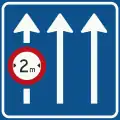 L11: Information on panel applies only to the lane(s) indicated
L11: Information on panel applies only to the lane(s) indicated L12: Information on panel applies only to the lane indicated
L12: Information on panel applies only to the lane indicated L13: Model sign traffic tunnel
L13: Model sign traffic tunnel L14: Hard shoulder
L14: Hard shoulder L15: Hard shoulder equipped with emergency telephone and fire extinguisher
L15: Hard shoulder equipped with emergency telephone and fire extinguisher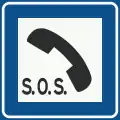 L16: Emergency telephone
L16: Emergency telephone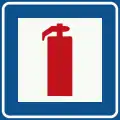 L17: Fire extinguisher
L17: Fire extinguisher L18: Emergency telephone and fire extinguisher
L18: Emergency telephone and fire extinguisher.svg.png.webp) L19: Nearest exit or second nearest exits in the directions and at the distances indicated on the sign
L19: Nearest exit or second nearest exits in the directions and at the distances indicated on the sign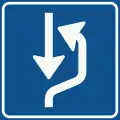 L20: Passing area on right-hand side of the road
L20: Passing area on right-hand side of the road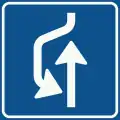 L21: Passing area on left-hand side of the road
L21: Passing area on left-hand side of the road Road Barriers
Road Barriers
Retired signs (no longer used)
Below, signs are withdrawn or replaced with new diagrams of the same meaning.
Attention signs
Priority
.svg.png.webp) B1: Priority road (1941-1990)
B1: Priority road (1941-1990) B1: Priority road (1941-1950)
B1: Priority road (1941-1950).svg.png.webp) B2: End of priority road (1950-1990)
B2: End of priority road (1950-1990)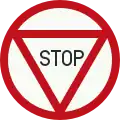 B7: Stop: Give priority to traffic on the main road ahead (1950-1966)
B7: Stop: Give priority to traffic on the main road ahead (1950-1966).svg.png.webp) B7: Stop: Give priority to traffic on the main road ahead (1966-1979)
B7: Stop: Give priority to traffic on the main road ahead (1966-1979)
Road closed prohibition and mandatory
 C6: No access for vehicles with more than two wheels (1966-1990)
C6: No access for vehicles with more than two wheels (1966-1990) C7: No access for goods vehicles (1966-1990)
C7: No access for goods vehicles (1966-1990) C8: No access for motor vehicles that cannot exceed 25 km/h (1966-1990)
C8: No access for motor vehicles that cannot exceed 25 km/h (1966-1990)_Rotterdam_(2020).jpg.webp) no pedestrians
no pedestrians Pedestrians only
Pedestrians only
Traffic regulations
 G3: Expressway (1941-1966)
G3: Expressway (1941-1966)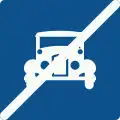 G4: End of Expressway (1941-1966)
G4: End of Expressway (1941-1966) G3: Expressway (1966-1990)
G3: Expressway (1966-1990) G4: End of Expressway (1966-1990)
G4: End of Expressway (1966-1990) G5: Living street (1966-1988)
G5: Living street (1966-1988)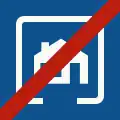 G6: End of Living street (1966-1988)
G6: End of Living street (1966-1988).svg.png.webp) G5: Living street (1988-1990)
G5: Living street (1988-1990).svg.png.webp) G6: End of Living street (1988-1990)
G6: End of Living street (1988-1990)
Warning Signs
.svg.png.webp) J37: Danger
J37: Danger J24: Cyclist crossing
J24: Cyclist crossing OB618: Uneven road, larger trucks or other big vehicles may get stuck. This sign is placed before a railroad crossing.
OB618: Uneven road, larger trucks or other big vehicles may get stuck. This sign is placed before a railroad crossing.
Information
 L2: Pedestrian crossing (1966-1990)
L2: Pedestrian crossing (1966-1990)
References
- ↑ Through Dutch colonial history, lasting into 1975.
External links
This article is issued from Wikipedia. The text is licensed under Creative Commons - Attribution - Sharealike. Additional terms may apply for the media files.
